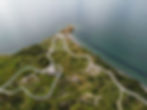
Stp75 Pointe du Hoc
Famous batterie secured by US 2nd Rangers on D-Day

Stp75 site overview

What to see
Located to the west of Omaha and the east of Utah landing beaches, Pointe du Hoc was a huge batterie with the capability of firing on both landing areas - if the guns suspected of being at the location would have actually been in their emplacements on D-Day.
As most know, the six 155mm guns had been withdrawn from their unprotected positions and casemates in the days preceding June 6, 1944 and five were found stored in an orchard to the rear of the batterie, the sixth gun was nearby too.
The strongpoint is one of the most documented locations of WW2 thanks to the heroics of the US 2nd Rangers who climbed the 100ft cliff face under fire to storm the batterie and secure it, holding out for two days until support arrived.
Located on top of the gun batterie’s fire control post just behind the pointe itself there's a memorial to the 2nd Rangers. In the shape of a Rangers' dagger, the inscription on the plinth reads: ‘To the Heroic Ranger Commandoes of the 116th Infantry who, under the command of Colonel James Earl Rudder of the First American Division, attacked and took possession of the Pointe du Hoc’.
The Pointe du Hoc site has largely been fenced off to help protect the site from the millions of visitors who walk its paths each tourist season but you can still see many of the structures including the original open emplacements where the guns would have stood, and the two R694 casemates that replaced the open emplacements, as you walk the circular track around the site.
Also at Stp75 are numerous R134 twin-roomed ammunition bunkers - in various states of damage - plus R501 and R502 single and double group shelters for personnel, and a R661 underground hospital shelter - the remains of which can be found at the rear of the complex.
Protecting the site from east and west are two L409A type casemates - large, two-storey anti-aircraft positions which featured 37mm Flak 36 cannons on top and an ammunition store below. The western L409A was fenced off in 2020 due to its proximity to the cliff edge so can't be accessed but the eastern bunker still features a viewing platform on top where you can look over the sea and batterie site.
In the days prior to D-Day the site received a lot of attention from Allied aircraft and it's only when you view the site from above that you can appreciate the number of bomb craters on this cliff top strongpoint - simply incredible!
In early 2022 a large section on the eastern side of the stack which makes up the pointe collapsed into the sea and it’s only a matter of time before natural erosion takes away the rest although plans are being put in place to slow this process.
During the rough winter of 2022/2023 there were more cliff collapses to the east of the point and so the long-standing path along the eastern part of the site and the L409A anti-aircraft gun position and forward open emplacement were closed to the public for safety with little likelihood of those areas re-opening. A new path through the site has been created and this does give you a great view of the structures further inland of the cliffs.
Experts estimate that the R636 observation post and memorial have around 10 to 15 years left before they succumb to erosion, even with a multi-million dollar safeguarding package in place. Go and visit while you can!
Gallery




